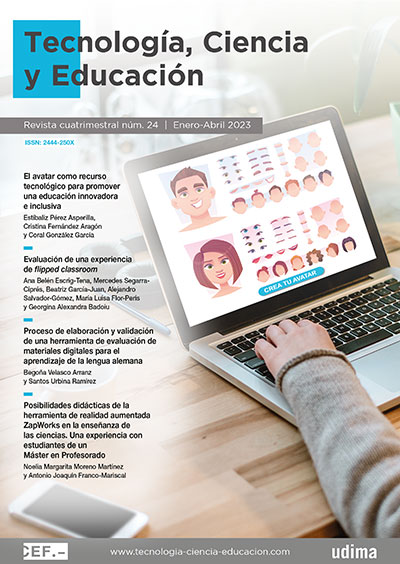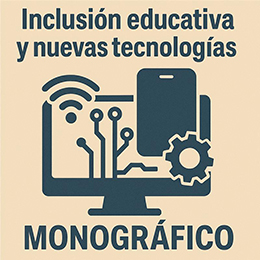Proyecto de inclusión tecnológica para el estudio de la percusión corporal
DOI:
https://doi.org/10.51302/tce.2023.3265Palabras clave:
tecnologías de la información y la comunicación (TIC), educación musical, percusión corporal, gamificación, lúdico, metodología activa, tecnología educativaResumen
El cuerpo y la voz son los primeros instrumentos que se emplean en la educación musical siguiendo las premisas de las principales pedagogías musicales. En lo referente a las posibilidades sonoras del cuerpo en la práctica instrumental, la percusión corporal es una de las actividades que se realiza en las aulas de educación musical en la etapa de Primaria. Sin embargo, como toda practica instrumental, requiere un seguimiento por parte del docente especialista en la materia para que los estudiantes (niños y niñas) adquieran los conocimientos de forma sistematizada y en orden creciente de dificultad. Debido a que la duración de las sesiones de Música en esta etapa educativa es de apenas una hora y que incluyen a un grupo numeroso de estudiantes, se hace muy complejo realizar una enseñanza y seguimiento individualizado del alumnado. Por esta razón, resulta necesario que el alumnado continúe con la práctica instrumental de forma autónoma fuera del centro educativo. Para evitar la ausencia de esa guía fundamental se crea este proyecto de inclusión de una app en este proceso de enseñanza-aprendizaje de la percusión corporal.
Descargas
Citas
Banfield, J. y Wilkerson, B. (2014). Increasing student intrinsic motivation and self-efficacy through gamification pedagogy. Contemporary Issues in Education Research, 7(4), 291-298.
Bernabé Villodre, M.ª M. (2015). El lenguaje musical y las nuevas tecnologías en las enseñanzas profesionales de música. Revista Internacional de Tecnologías en la Educación, 2(2), 79-87. https://bit.ly/3dUQ3PL
Bharamgoudar, R. (2018). Gamification. The Clinical Teacher, 15(3), 268-269. https://doi.org/10.1111/tct.12787
Bonk, C. J. y Dennen, V. P. (2005). Massive Multiplayer Online Gaming: A Research Framework for Military Training and Education. Advanced Distributed Learning. Office of the Under Secretary of Defense for Personnel and Readiness.
Bromley, K. (2012). Using smartphones to supplement classroom reading. Reading Teacher, 66(4), 340-344. https://doi.org/10.1002/TRTR.01130
Bueno Rodríguez, J. A. (2016). Aprendizaje basado en juegos. Juegos y juguetes en la vida social: IX Jornadas nacionales de ludotecas. Ponencias y comunicaciones (pp. 139-152). Comarca de la Sierra de Albarracín.
Burton, S. L. y Pearsall, A. (2016). Music-based iPad app preferences of young children. Research Studies in Music Education, 38(1), 75-91. https://doi.org/10.1177/1321103x16642630
Calderón-Garrido, D., Cisneros, P., García, I. D. y Heras-Fernández, R. de las. (2019). La tecnología digital en la educación musical: una revisión de la literatura científica. Revista Electrónica Complutense de Investigación en Educación Musical-RECIEM, 16, 43-55.
Carrera, B. y Mazzarella, C. (2001). Vygotsky: enfoque sociocultural. Educere. La Revista Venezolana de Educación, 5(13), 41-44.
Carretero-Martínez, A., Romero-Naranjo, F. J., Pons-Terrés, J. M. y Crespo-Colomino, N. (2014). Cognitive, visual-spatial and psychomotor development in students of primary education through the body percussion-BAPNE method. Procedia-Social and Behavioral Sciences, 152, 1.282-1.287.
Chacón, P. (2008). El juego didáctico como estrategia de enseñanza y aprendizaje. ¿Cómo crearlo en el aula? Nueva Aula Abierta, 16.
Christy, K. R. y Fox, J. (2014). Leaderboards in academic contexts: a test of stereotype threat and social comparison explanations for women's math performance. Computers & Education, 78, 66-77. http://dx.doi.ogr/10.106/j.compedu.2014.05.005
Conde Caveda, J. L., Martín Moreno, C. y Viciana Garófaro, V. (2004). Las canciones motrices II: metodología para el desarrollo de las habilidades motrices en Educación Infantil y Primaria a través de la música (3.ª ed.). Inde.
Cornellà, P., Estebanell, M. y Brusi, D. (2020). Gamificación y aprendizaje basado en juegos. Consideraciones generales y algunos ejemplos para la enseñanza de la geología. Enseñanza de las Ciencias de la Tierra, 28(1), 519.
Correa García, R., Duarte Hueros, A. y Guzmán Franco, M. (2016). Horizontes educativos de los videojuegos. Propuestas y reflexiones de futuros maestros y educadores sociales. Educar, 53(1), 67-88. http://dx.doi.org/10.5565/rev/educar.849
Correa Rodríguez, E. (2016). Los beneficios de la música. Innovación y Experiencias Educativas, 26, 1-10.
Cortizo Pérez, J. C., Carrero García, F., Monsalve Piqueras, B., Velasco Collado, A., Díaz del Dedo, L. I. y Pérez Martín, J. (2011). Gamificación y docencia: lo que la universidad tiene que aprender de los videojuegos. VIII Jornadas Internacionales de Innovación Universitaria: Retos y Oportunidades del Desarrollo de los Nuevos Títulos en Educación Superior.
Delgado Linares, I. (2011). El juego infantil y su metodología. Paraninfo.
Denny, P. (2013). The effect of virtual achievements on student engagement. CHI'13: Proceedings of the SIGCHI Conference on Human Factors in Computing Systems (pp. 763-772). Association for Computing Machinery.
Deterding, S., Dixon, D., Khaled, R. y Nacke, L. (2011). From game design elements to gamefulness: defining «gamification». MindTrek'11: Proceedings of the 15th International Academic MindTrek Conference: Envisioning Future Media Environments (pp. 9-15). Association for Computing Machinery.
Dewey, J. (1997). How We Think. Dover Publications.
Egilmez, G. y Gedik, R. (2018). A gamification approach for experiential education of inventory control. 2018 ASEE Annual Conference & Exposition. Salt Lake City, Utah. https://bit.ly/2XehoGs
Gardner, H. (1993). Multiple Intelligences: The Theory and Practice. Basic Books.
Gustems-Carnicer, J., Calderón-Garrido, D., Navarro, M. y Segura, G. (2020). La flauta de pico en la escuela: la opinión del maestro de música. Revista Electrónica de LEEME, 46, 17-33. https://doi.org/10.7203/LEEME.46.17260
Hägglund, P. (2012). Taking Gamification to the Next Level (Tesis, Umeå Universitet).
Hallam, S. (2001). The development of meta-cognition in musicians: implications for education. The British Journal of Music Education, 18(1), 27-39. https://doi.org/10.1017/S0265051701000122
Higgins, E., Grant, H. y Shah, J. (1999). Self-regulation and quality of life: emotional and no emotional life experiences. En D. Kahneman, E. Diener y N. Schwarz (Eds.), Well-Being: The foundations of Hedonic Psychology (pp. 244-266). Russell Sage Foundation.
Howard, S. K., Yang, J., Ma, J., Maton, K. y Rennie, E. (2018). App clusters: exploring patterns of multiple app use in primary learning contexts. Computers & Education, 127, 154-164. https://doi.org/10.1016/j.compedu.2018.08.021
Ipiña, A (2014). Método Dalcroze: musicalidad y ritmo. http://es.slideshare.net/alicreativa/mtodo-dalcroze-musicalidad-y-ritmo
Jacques-Dalcroze, E. (2000). Rhythm, Music and Education. The Dalcroze Society Inc.
Jeong, J. S., González-Gómez, Cañada-Cañada, F., Gallego-Picó, A. y Bravo, J. C. (2019). Effects of active learning methodologies on the students' emotions, self-efficacy beliefs and learning outcomes in a science distance learning course. J. Journal of Science Education and Technology, 9, 217-227.
Kageyama, N. (2013). How Many Hours a Day Should You Practice? https://bulletproofmusician.com/how-many-hours-a-day-should-you-practice/?
Kapp, K. (2012). Games, gamification, and the quest for learner engagement. Training and Development, 66(6), 64-68.
Kirriemuir, J. y McFarlane, A. (2004). Literature Review in Games and Learning. https://www.researchgate.net/publication/32231341_Literature_Review_in_Games_and_Learning
Kühn Hildebrandt, C. (2019). Whose interest is educational technology serving? Who is included and who I excluded? RIED. Revista Iberoamericana de Educación a Distancia, 22(1), 207-220. https://doi.org/10.5944/ried.22.1.22293
Lizarán, C. y López, A. M. (2021). La flauta dulce en Educación Primaria: estudio de caso sobre la eficacia de diferentes metodologías para el aula. Revista InstrumentUM, 1, 13-29. https://digitum.um.es/digitum/handle/10201/114107?mode=full
Macià Bordalba, M. y Garreta Bochata, J. (2017). Accesibilidad y alfabetización digital: barreras para la integración de las TIC en la comunicación familia/escuela. Revista de Investigación Educativa, 36(1), 239-257. https://doi.org/10.6018/rie.36.1.290111
Marić, S. (2015). Online gaming to learn music and english language in music and ballet school solfeggio education. Hellenic Journal of Music, Education, and Culture, 6(2), 10. https://bit.ly/2yEjXYf
Ortiz-Colón, A. M., Jordán, J. y Agredal, M. (2018). Gamificación en educación: una panorámica sobre el estado de la cuestión. Educação e Pesquisa, 44(0), 1-17. https://doi.org/10.1590/s1678-4634201844173773
Padilla, S., Halley, F. y Chantler, J. C. (2011). Improving product browsing whilst engaging users. Digital Engagement, 11, 15-17.
Piaget, J. (1981). La teoría de Piaget. Infancia y Aprendizaje, 4(2), 13-54.
Perrotta, C., Featherstone, G., Aston, H. y Houghton, E. (2013). Game based learning: latest evidence and future directions. The NFER Research Programme: Innovation in Education. Slough-Berkshire. https://www.nfer.ac.uk/publications/game01/game01.pdf
Prensky, M. (2001). Digital natives, digital immigrants. On the Horizon, 9(5), 1-6.
Romero Naranjo, F. J. (2013). Science and art of body percussion: a review. Journal of Human Sport and Exercise, 8(2), 442-457. https://www.researchgate.net/publication/288475620_Science_art_of_body_percussion_A_review
Romero Naranjo, F. J. (2016). Percusión corporal, estimulación cognitiva y socioemocional a través del método BAPNE. Universidad de Alicante.
Simões, J., Díaz Redondo, R. y Fernández Vilas, A. (2013). A social gamification framework for a K-6 learning platform. Computers in Human Behavior, 29(2), 345-353.
Sloboda, J. A. (2000). Individual differences in music performance. Trends in Cognitive Sciences, 4(10), 397-403. https://doi.org/10.1016/S1364-6613(00)01531-X
Thaut, M. H. (2008). Rhythm, Music, and the Brain: Scientific Foundations and Clinical Applications. Routledge.
Willems, E. (1975). El valor humano de la educación musical. Éditions Pro Música.
Wuytack, J. (1971). Activatie middelen bij het muziek luisteren. Adem: Tijdschrift voor Muziekkultuur, 3.
Wuytack, J. (1975). Het musicogram. Adem: Tijdschrift voor Muziekkultuur, 1.
Wuytack, J. (1989). Fiche pratique sur l'audition musicale active. Musique et Culture, 34(3).
Wuytack, J. y Boal-Palheiros, G. (2009). Audición musical activa con el musicograma. Eufonía. Didáctica de la Música, 47, 43-55.
Wuytack, J. y Schollaert, P. (1972). Actief muziek beluisteren. De Monte.
Yllana-Prieto, F., Jeong, J. S. y González-Gómez, D. (2021). An online-based edu-escape room: a comparison study of a multidimensional domain of PSTs with flipped sustainability-STEM contents. Sustainability, 13(3), 1-18.
Descargas
Publicado
Cómo citar
Número
Sección
Licencia
Derechos de autor 2023 Paloma Bravo Fuentes

Esta obra está bajo una licencia internacional Creative Commons Atribución-NoComercial-SinDerivadas 4.0.


























